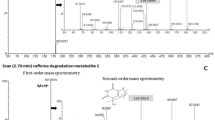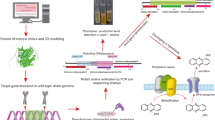Abstract
Caffeine (1,3,7-trimethylxanthine), a ubiquitous component of human diet has been suggested as a chemical indicator of ecosystem impacts of sewage spills and treated effluent discharges because it is not sufficiently metabolized by wastewater microorganisms. This study identified enzymes responsible for caffeine metabolism in sewage bacteria. Pseudomonas putida biotype A (ATCC 700097) originally isolated as a rare caffeine-degrading organism in domestic wastewater exhibited diauxic growth on caffeine, concomitant with the expression of a P450-type cytochrome and peroxidase enzyme activities. Initial growth phase lasted 13.8 ± 1.4 h with a growth rate that was five times slower than the secondary growth phase that lasted 5.5 ± 1.2 h. Molecular and enzymatic characteristics of the cytochrome P450-type enzyme differ from the previously described cytochrome P450 (P450cam) of P. putida (ATCC 17453) involved in camphor metabolism. The caffeine-inducible cytochrome P450-type enzyme exhibited a carbon monoxide difference spectrum peak at 450 nm, but does not allow growth on camphor. Caffeine induced production of haem-associated peroxidase activity was confirmed with 3,3′, 5,5′-tetramethylbenzidine–H2O2 reaction in polyacrylamide gels. Polymerase chain reaction (PCR) primers derived from the gene for cytochrome P450cam (camC) of P. putida (ATCC 17453) did not yield an amplification product when DNA extracted from P. putida strain ATCC 700097 was used as template. The data demonstrate that caffeine is metabolized through a specific biphasic pathway driven by oxygen-demanding enzymes.
Similar content being viewed by others
References
Aherne, G.W. & Briggs, R. 1989 The relevance of the presence of certain synthetic steroids in the aquatic environment. Journal of Pharmaceutics and Pharmacology 41, 735–736.
Asperger, O., Muller, R. & Kleber, H.P. 1985 Reconstitution of n-alkane-oxidizing activity of a purified cytochrome P-450 from Acinetobacter calcoaceticus strain EB 104. Developments in Biochemistry 27, 447–450.
Bechtel, Y.C., Lelouet, H., Hrusovsky, S., Brientini, M.P., Mantion, G., Paintoud, G., Miguet, J.P. & Bechtel, P.R. 2001 Caffeine metabolism before and after liver transplantation. International Journal of Clinical Pharmacology and Therapeutics 39, 53–60.
Belfroid, A.C., Van der Horst, A., Vethaak, A.D., Schäfer, A.J., Rijs, G.B.J., Wegener, J. & Cofino, W.P. 1999 Analysis and occurrence of estrogenic hormones and their glucuronides in surface water and waste water in The Netherlands. Science of the Total Environment 225, 101–108.
Berg, A.K., Gustafsson, J.A., Ingelman-Sundberg, M. & Carlstrom, K. 1976 Characterization of a cytochrome P-450 dependent steroid hydroxylase system present in Bacillus megaterium. Journal of Biological Chemistry 251, 2831–2838
Berthou, F., Guillois, B., Riche, C., Dreano, Y., Jacqz-Aigrain, E. & Beaune, P. 1992 Interspecies variations in caffeine metabolism related to cytochrome P4501A enzymes. Xenobiotica 22, 671–680.
Bhattacharyya, S. & Paul, A.K. 2001 Enhanced UV sensitivity of Thiobacillus ferrooxidans resulting from caffeine and acriflavine treatment of irradiated cells. Current Microbiology 43, 149–153.
Cardini, G. & Jurtshuk, P. 1968 Cytochrome P-450 involvement in the oxidation of n-octane by cell-free extracts of Corynebacterium sp. strain 7E1C. Journal of Biological Chemistry 243, 6070–6072.
Daniel, P.O., James, A.R. & Kenneth, J.L. 1988 Identification of constitutive and herbicide-inducible cytochrome P-450 in Streptomyces griseolus. Archives of Microbiology 149, 406–412.
Dan-Shya Tang-Liu, Williams, R.L. & Riegelman, S. 1982 Disposition of caffeine and its metabolites in man. Journal of Pharmacology and Experimental Therapeutics 224, 180–185.
Dardas, A., Gal, D., Baralle, M., Sauret-Ignazi, G., Sterjiades, R. & Pelmont, J. 1985 The demethylation of guaiacol by a new bacterial cytochrome P-450. Archives of Biochemistry and Biophysics 236, 585–592.
Daughton, C.G. & Ternes, T.A. 1999 Pharmaceuticals and personal care products in the environment: Agents of subtle change? Environmental Health Perspectives 107(Suppl. 6), 907–938.
Elhmmali, M.M., Roberts, D.J. & Evershed, R.P. 2000 Combined analysis of bile acids and sterols/stanols from riverine particulates to assess sewage discharges and other fecalsources. Environmental Science and Technology 34, 39–46.
Gould, J.P. & Hay, T.R. 1982 The nature of the reactions between chlorine and purine and pyrimidine bases: Products and kinetics. Water Science and Technology 14, 629–640.
Grimes, D.J., Singleton, F.L. & Colwell, R.R. 1984 Allogenic succession of marine bacterialcommunitie s in response to pharmaceuticalwaste. Journal of Applied Bacteriology 57, 247–261.
Hietanen, E., Laitinen, M. & Hanninen, O. (eds.) 1982 Cytochrome P-450, Biochemistry, Biophysics, and Environmental Implications. 822 pp. Amsterdam: Elsevier Biomedical Press. ISBN 0444804595.
Kihlman, B.A. 1974 Effects of caffeine on the genetic material. Mutation Research 26, 53–71.
Kihlman, B.A. 1977 Caffeine and Chromosomes. p. 249. Elsevier Publishers, New York. ISBN 0444414916.
Koga, H., Rauchfuss, B. & Gunsalus, I.C. 1985 P450cam gene cloning and expression in Pseudomonas putida and Escherichia coli. Biochemical and Biophysical Research Communications 130, 412–417.
Kümmerer, K. (ed.) 2001 Pharmaceuticals in the Environment: Sources, Fate, Effects and Risks, New York: Springer-Verlag. ISBN 3540410678.
Luyten, E., Swinnen, E., Vlassak, K., Verreth, C., Dombrecht, B. & Vanderleyden, J. 2001 Analysis of a symbiosis-specific cytochrome P450 homolog in Rhizobium sp. BR816. Molecular Plant-Microbe Interactions 14, 918–924.
Madyastha, K.M., Sridhar, G.R., Vadiraja, B.B. & Madhavi, Y. 1999 Purification and partialcharacterizatio n of caffeine oxidase - A novelenzyme from a mixed culture consortium. Biochemical and Biophysical Research Communications 263, 460–464.
Mazaferra, P., Olsson, O. & Sandberg, G. 1996 Degradation of caffeine and related methylxanthines by Serratia marcescens isolated from soil under coffee cultivation. Microbial Ecology 31, 199–207.
Munro, A.W. & Lindsay, J.G. 1996 Bacterialcytochro me P450. Molecular Microbiology 20, 1115–1125.
Nelson, D.R. 1999. Cytochrome P450 and the individuality of species. Archives of Biochemistry and Biophysics 369, 1–10.
Ogunseitan, O.A. 1996 Removalof caffeine from wastewater by Pseudomonas putida Biotype A: Implications for water pollution index. World Journal of Microbiology and Biotechnology. 12, 251–256.
Omura, T. 1999 Fourty years of cytochrome P-450. Biochemical and Biophysical Research Communications 266, 690–698.
Ornstein, R.L. 1991 Why timely bioremediation of synthetics may require rationalenzyme design: preliminary report on redesigning cytochrome P450cam for trichloroethylene dehalogenation. In eds. Hinchee, R.E. & Olfenbuttel, R.F. On-Site Bioreclamation. Boston, MA: Butterworth-Heinemann. ISBN 0750693029.
Peterson, J.A. & Lu, J.-Y. 1991 Bacterialcytochrome P-450: isolation and identification. Methods in Enzymology 206, 612–620.
Ropp, J.D., Gunsalus, I.C. & Sligar, S.G. 1993 Cloning and expression of a member of a new cytochrome P-450 family: cytochrome P-450lin (CYP111) from Pseudomonas incognita. Journal of Bacteriology 175, 6028–6037.
Sanderson, J.T., Seinen W., Giesy J.P. & Van den Berg M. 2000 2-Chloro-s-triazine herbicides induce aromatase (CYP19) activity in H295R human adrenocortical carcinoma cells: A novel mechanism for estrogenicity? Toxicological Science 54, 121–127.
Sariaslani, F.S. 1991 Microbial cytochromes P-450 and xenobiotic metabolism. Advances in Applied Microbiology 36, 133–177.
Schlichting, I., Berendzen, J., Chu, K., Stock, A.M., Maves, S.A., Benson, D.E., Sweet, R. M., Ringe, D., Petsko, G.A. & Sligar, S.G. 2000 The catalytic pathway of cytochrome P450cam at atomic resolution. Science 287, 1615–1622.
Seiler, R.L., Zaugg, S.D., Thomas, J.M. & Howcroft, D.L. 1999 Caffeine and pharmaceuticals as indicators of waste water contamination in wells. Ground Water 37, 405–410.
Snyder, M.J. 2000 Cytochrome P450 enzymes in aquatic invertebrates: recent advances and future directions. Aquatic Toxicology 48, 529–547.
Stegeman, J.J., Schlezinger, J.J., Craddock, J.E. & Tillitt, D.E. 2001 Cytochrome P450 1A expression in midwater fishes: Potential effects of chemicalcontamin ants in remote oceanic zones. Environmental Science and Technology 35, 54–62.
Tabak, H.H., Bloomhu., R.N. & Bunch, R.L. 1981 Steroid hormones as water pollutants II. Studies on the persistence and stability of naturalurinary and synthetic ovulation-inhibiting hormones in treated wastewaters. Developments in Industrial Microbiology 22, 497–519.
Ternes, T.A, Stumpf, M., Mueller, J., Haberer, K., Wilken, R-D. & Servos, M. 1999 Behavior and occurrence of estrogens in municipalsewage treatment plants - I. Investigations in Germany, Canada and Brazil. Science of the Total Environment 225, 81–90.
Thomas, P.E., Ryan, D. & Levin W. 1976 An improved staining procedure for the detection of the peroxidase activity of cytochrome P-450 on sodium duodecyl sulfate polyacrylamide gels. Analytical Biochemistry 75, 168–176.
Unger, B.P., Gunsalus, I.C. & Sligar, S.G. 1986 Nucleotide sequence of the Pseudomonas putida cytochrome P-450cam gene and its expression in Escherichia coli. Journal of Biological Chemistry 261, 1158–1163
Waterman, M.R. & Johnson, E.F. (eds.) 1991 Cytochrome P450. Methods in Enzymology Vol. 206. San Diego: Academic Press, Inc., ISBN 0121821072.
White, P.A. & Rasmussen, J.B. 1998 The genotoxic hazards of domestic wastes in surface waters. Mutation Research 410, 223–236.
Woolfolk, C.A. 1975. Metabolism of N-methylpurines by a Pseudomonas putida strain isolated by enrichment on caffeine as the sole source of carbon and nitrogen. Journal of Bacteriology 123, 1088–1106.
Author information
Authors and Affiliations
Rights and permissions
About this article
Cite this article
Ogunseitan, O. Caffeine-inducible enzyme activity in Pseudomonas putida ATCC 700097. World Journal of Microbiology and Biotechnology 18, 423–428 (2002). https://doi.org/10.1023/A:1015583316426
Issue Date:
DOI: https://doi.org/10.1023/A:1015583316426




